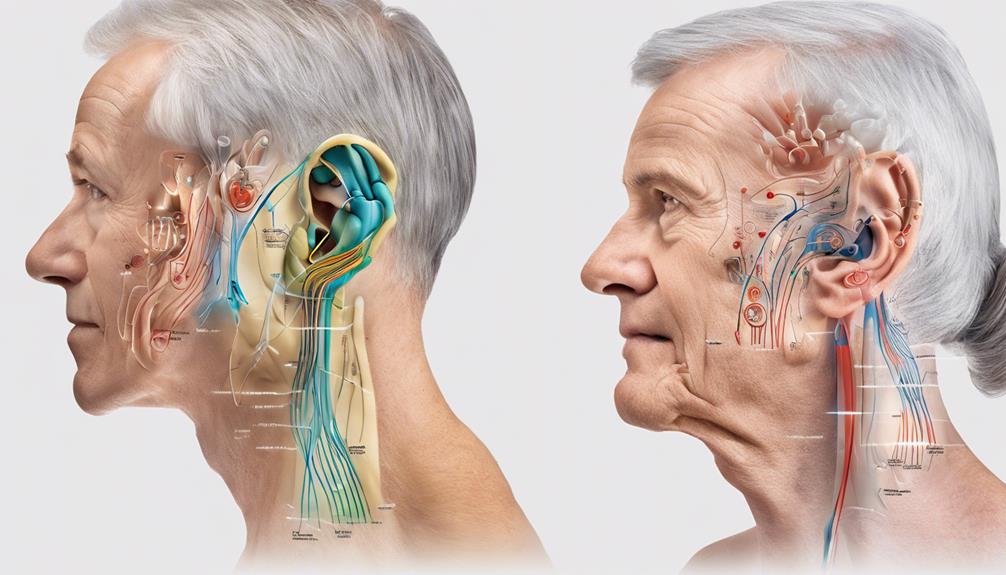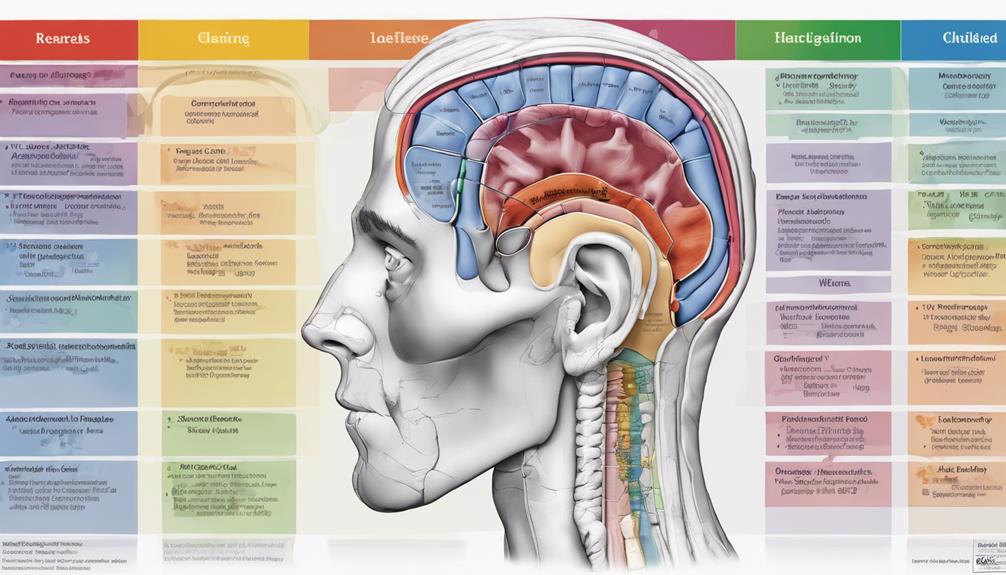Our aim in examining the intricacies of mixed hearing loss is to clarify the factors that define this condition. Understanding the connection between sensorineural and conductive components can help unveil possible treatment methods and anticipate results.
By examining the nuances of coding classifications and diagnostic criteria, we can pave the way for more accurate assessments and tailored interventions.
But what lies beyond these classifications and definitions? What hidden insights await us in the realm of mixed hearing loss that could shape our understanding and improve patient care?
Key Takeaways
- Mixed hearing loss involves a combination of conductive and sensorineural impairments.
- Specific interventions are tailored based on the type of hearing loss (sensorineural, conductive).
- Diagnosis of mixed hearing loss requires audiometry testing for treatment planning.
- Treatment options include hearing aids, cochlear implants, and rehabilitation programs.
ICD-10-CM Coding for Mixed Hearing Loss
In identifying and coding for mixed hearing loss, we utilize ICD-10-CM code H90.6 to specify bilateral conductive and sensorineural impairment. This specific code falls under the Diseases of the ear and mastoid process chapter, aiding healthcare professionals in accurately documenting and billing for this condition. It's crucial to pay attention to Excludes1 notes related to H90.6, as they help differentiate mixed hearing loss from other similar conditions like noise-induced or sudden idiopathic hearing loss.
Proper documentation and coding are vital not only for billing purposes but also for treatment planning. Understanding the nuances of coding for mixed hearing loss allows healthcare providers to create tailored treatment strategies that address both the conductive and sensorineural components of the impairment. By using the appropriate ICD-10-CM code, we ensure that patients receive the necessary care and interventions to manage their bilateral hearing loss effectively.
Types of Hearing Impairments

Our exploration of hearing impairments delves into the various types that encompass the spectrum of auditory challenges individuals may experience. Hearing impairments can be classified into different categories such as sensorineural hearing loss, conductive hearing loss, auditory processing disorder, and mixed conductive and sensorineural hearing loss. Each type presents distinct challenges and requires specific interventions for management.
Sensorineural hearing loss affects the inner ear or auditory nerve and can be caused by aging, genetics, exposure to loud noise, or certain illnesses. On the other hand, conductive hearing loss occurs when sound waves can't reach the inner ear, often due to issues in the outer or middle ear. Diagnosis of hearing loss involves audiometry tests to determine the type and extent of impairment, which is crucial for developing a proper treatment plan.
Medical coding, including ICD-10-CM codes, plays a vital role in accurately documenting the type of hearing loss for billing purposes and treatment tracking. Treatment options may include hearing aids, cochlear implants, or surgical interventions depending on the specific needs of the individual.
Causes of Mixed Hearing Loss

Mixed hearing loss occurs when both conductive and sensorineural factors combine to impact auditory function in both ears. The causes of mixed hearing loss are varied and can include:
- Chronic ear infections: Persistent infections can lead to conductive hearing loss by blocking sound conduction through the ear.
- Otosclerosis: Abnormal bone growth in the middle ear can disrupt sound transmission, contributing to conductive hearing loss.
- Head trauma: Injuries to the head can damage the structures involved in hearing, causing a mix of conductive and sensorineural hearing loss.
- Exposure to loud noise: Prolonged exposure to loud sounds can damage the delicate hair cells in the inner ear, leading to sensorineural hearing loss.
Diagnosis of mixed hearing loss typically involves audiometric testing to evaluate the extent of both types of hearing loss. Treatment options may include hearing aids to amplify sound, surgical interventions to correct conductive issues, or other personalized approaches to address the specific components of mixed hearing loss.
Symptoms of Hearing Loss

What common signs indicate the presence of hearing loss? Symptoms of mixed hearing loss may manifest as difficulty understanding speech, ringing in the ears, and perceiving sounds as muffled or distorted. Individuals with mixed hearing loss often experience a combination of symptoms from both conductive and sensorineural hearing loss.
This can lead to challenges in various aspects of life, including communication, social interactions, and engaging in daily activities. Patients may struggle to follow conversations, especially in noisy environments, and may find it hard to hear high-frequency sounds clearly.
Recognizing these symptoms early is crucial for seeking proper diagnosis and management. Addressing mixed hearing loss promptly can help improve the quality of life for affected individuals, enhance communication abilities, and prevent further deterioration of hearing. Therefore, it's essential to consult with healthcare professionals for accurate diagnosis and appropriate management strategies tailored to each individual's specific needs.
Treatment Options for Mixed Hearing Loss

Exploring diverse treatment modalities for mixed hearing loss involves considering options such as hearing aids, cochlear implants, or bone conduction devices. When managing mixed hearing loss, various interventions and strategies can be utilized to address both the conductive and sensorineural components effectively.
Here are some key treatment options to consider:
- Hearing Aids: These devices can amplify sounds for individuals with residual hearing, improving overall auditory perception.
- Cochlear Implants: Suitable for severe to profound hearing loss, cochlear implants bypass damaged portions of the ear to directly stimulate the auditory nerve.
- Bone Conduction Devices: By transmitting sound through bone vibrations, these devices can benefit individuals with conductive hearing loss or single-sided deafness.
- Rehabilitation Programs: Engaging in auditory training and speech therapy can enhance communication skills and quality of life for those with mixed hearing loss.
Incorporating a multidisciplinary approach involving audiologists, otolaryngologists, and speech-language pathologists, along with regular monitoring and individualized treatment plans, is crucial for optimizing outcomes in managing mixed hearing loss effectively.
Frequently Asked Questions
What Is the ICD-10 Code for Mixed Hearing Loss?
The ICD-10 code for mixed hearing loss is H90.6, specifically indicating a combination of conductive and sensorineural hearing loss in both ears. It falls under Diseases of the ear and mastoid process.
The long descriptor for H90.6 is 'Mixed conductive and sensorineural hearing loss, bilateral.' Excludes1 notes clarify conditions that shouldn't be coded together, like deafness or noise-induced hearing loss.
Accurate use of H90.6 is crucial for billing, treatment, and tracking.
What Types of Hearing Loss Are Mixed?
When discussing the types of hearing loss that are mixed, it's important to note that mixed hearing loss is a combination of both conductive and sensorineural hearing loss in the same ear.
This means that individuals with mixed hearing loss experience issues with sound transmission through the outer or middle ear, as well as damage to the inner ear or auditory nerve.
Proper diagnosis and treatment are crucial in addressing this complex condition.
What Is the ICD-10 Code for Hearing Loss in Both Ears?
We've got the answer for you! The ICD-10 code for hearing loss in both ears is H90.6.
This code is specifically for mixed conductive and sensorineural hearing loss affecting both ears.
It falls under the Diseases of the ear and mastoid process chapter.
Accurate coding with H90.6 is essential for precise diagnosis and treatment planning.
Remember to pay attention to Excludes1 notes to ensure proper coding.
What Is the ICD 9 Code for Mixed Hearing Loss?
Let's clarify that the ICD-9 code for mixed hearing loss is 389.2. This code encompasses both conductive and sensorineural components, indicating a combination of hearing issues.
Accurate documentation of the type of hearing loss is crucial for proper coding, aiding in billing and treatment planning. Understanding this specific code streamlines healthcare processes and ensures comprehensive care for individuals with mixed hearing loss.
Conclusion
In conclusion, understanding the complexities of mixed hearing loss is crucial for accurate coding and effective treatment.
Just like a symphony requires all instruments to play in harmony, addressing both conductive and sensorineural components of hearing loss is essential for optimal outcomes.
By utilizing the ICD guide and staying informed on the latest coding changes, healthcare professionals can ensure comprehensive care for individuals with mixed hearing loss.
Let's keep striving for clear communication and improved quality of life.











